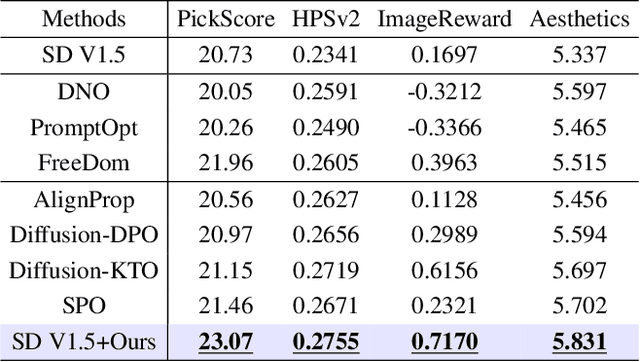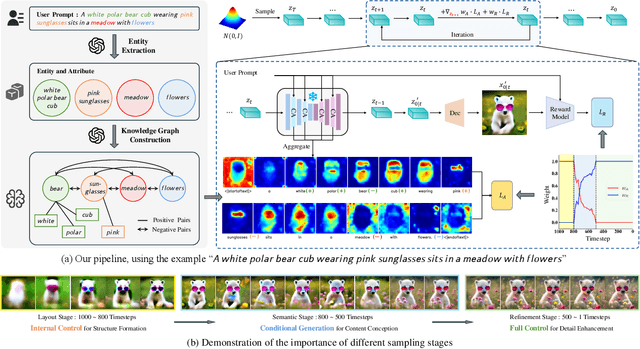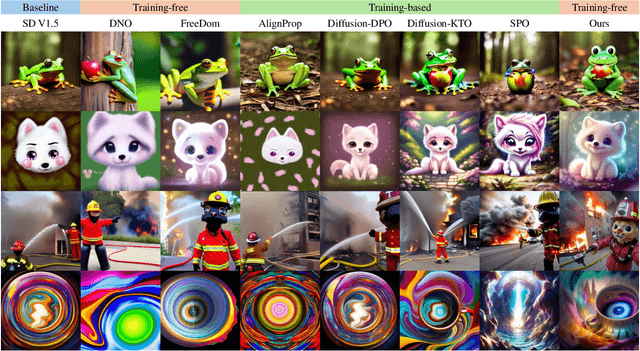Dong Gong
Little By Little: Continual Learning via Self-Activated Sparse Mixture-of-Rank Adaptive Learning
Jun 26, 2025Abstract:Continual learning (CL) with large pre-trained models is challenged by catastrophic forgetting and task interference. Existing LoRA-based Mixture-of-Experts (MoE) approaches mitigate forgetting by assigning and freezing task-specific adapters, but suffer from interference, redundancy, and ambiguous routing due to coarse adapter-level selection. However, this design introduces three key challenges: 1) Interference: Activating full LoRA experts per input leads to subspace interference and prevents selective reuse of useful components across tasks. 2) Redundancy: Newly added experts often duplicate or contradict existing knowledge due to unnecessary activation of unrelated ranks and insufficient reuse of relevant ones. 3) Ambiguity: Overlapping features across tasks confuse the router, resulting in unstable expert assignments. As more experts accumulate, earlier task routing degrades, accelerating forgetting. We propose MoRA, a Mixture-of-Rank Adaptive learning approach with self-activated and sparse rank activation for CL. Unlike mixing multiple low-rank matrices, MoRA decomposes each rank-r update into r rank-1 components, each treated as an independent expert, enabling fine-grained mixture of rank-1 expert utilization while mitigating interference and redundancy. To avoid ambiguous routing, we propose that each rank-1 expert can infer its own relevance via intermediate activations. Coupled with our proposed rank pruning and activation budgets, MoRA adaptively selects a sparse mixture of ranks per input. We validate MoRA on continual learning tasks with CLIP and large language models (LLMs), analyzing both in-domain learning and out-of-domain forgetting/generalization during fine-tuning. MoRA shows significant effectiveness on enhancing CL with PTMs, and improving generalization while mitigating forgetting.
Training-Free Motion Customization for Distilled Video Generators with Adaptive Test-Time Distillation
Jun 24, 2025Abstract:Distilled video generation models offer fast and efficient synthesis but struggle with motion customization when guided by reference videos, especially under training-free settings. Existing training-free methods, originally designed for standard diffusion models, fail to generalize due to the accelerated generative process and large denoising steps in distilled models. To address this, we propose MotionEcho, a novel training-free test-time distillation framework that enables motion customization by leveraging diffusion teacher forcing. Our approach uses high-quality, slow teacher models to guide the inference of fast student models through endpoint prediction and interpolation. To maintain efficiency, we dynamically allocate computation across timesteps according to guidance needs. Extensive experiments across various distilled video generation models and benchmark datasets demonstrate that our method significantly improves motion fidelity and generation quality while preserving high efficiency. Project page: https://euminds.github.io/motionecho/
Let Your Video Listen to Your Music!
Jun 23, 2025Abstract:Aligning the rhythm of visual motion in a video with a given music track is a practical need in multimedia production, yet remains an underexplored task in autonomous video editing. Effective alignment between motion and musical beats enhances viewer engagement and visual appeal, particularly in music videos, promotional content, and cinematic editing. Existing methods typically depend on labor-intensive manual cutting, speed adjustments, or heuristic-based editing techniques to achieve synchronization. While some generative models handle joint video and music generation, they often entangle the two modalities, limiting flexibility in aligning video to music beats while preserving the full visual content. In this paper, we propose a novel and efficient framework, termed MVAA (Music-Video Auto-Alignment), that automatically edits video to align with the rhythm of a given music track while preserving the original visual content. To enhance flexibility, we modularize the task into a two-step process in our MVAA: aligning motion keyframes with audio beats, followed by rhythm-aware video inpainting. Specifically, we first insert keyframes at timestamps aligned with musical beats, then use a frame-conditioned diffusion model to generate coherent intermediate frames, preserving the original video's semantic content. Since comprehensive test-time training can be time-consuming, we adopt a two-stage strategy: pretraining the inpainting module on a small video set to learn general motion priors, followed by rapid inference-time fine-tuning for video-specific adaptation. This hybrid approach enables adaptation within 10 minutes with one epoch on a single NVIDIA 4090 GPU using CogVideoX-5b-I2V as the backbone. Extensive experiments show that our approach can achieve high-quality beat alignment and visual smoothness.
Continual Learning on CLIP via Incremental Prompt Tuning with Intrinsic Textual Anchors
May 27, 2025Abstract:Continual learning (CL) enables deep networks to acquire new knowledge while avoiding catastrophic forgetting. The powerful generalization ability of pre-trained models (PTMs), such as the Contrastive Language-Image Pre-training (CLIP) model, has inspired a range of CL methods targeting new and specialized tasks, providing rich multi-modal embeddings that support lightweight, incremental prompt tuning. Existing methods often rely on complex designs built upon specific assumptions, such as intricate regularization schemes for prompt pools, specialized routing mechanisms, or multi-stage incrementations, that introduce additional-and possibly unnecessary-complexity, underutilizing CLIP's intrinsic capabilities. In this paper, we propose a concise CL approach for CLIP based on incremental prompt tuning that fully exploits its multi-modal structure and the stability of textual representations. Our method, Textual Prototype-guided Prompt Tuning (TPPT), introduces textual prototypes not merely as static classifiers, as in existing methods, but as stable anchors to guide the learning of visual prompts, thereby shaping the embedding space (i.e., TPPT-V). We show that our bidirectional supervision strategy enables more effective learning of new knowledge while reducing forgetting. To further close the vision-language gap during CL, we jointly optimizes visual and textual prompts (i.e., TPPT-VT). We also introduce a relational diversity regularization on the textual anchors to prevent embedding space collapse and mitigate correlated forgetting. Extensive experiments and analyses demonstrate the effectiveness of our proposed approach, highlighting the benefits of leveraging CLIP's intrinsic guidance for continual adaptation.
Hierarchical and Step-Layer-Wise Tuning of Attention Specialty for Multi-Instance Synthesis in Diffusion Transformers
Apr 14, 2025Abstract:Text-to-image (T2I) generation models often struggle with multi-instance synthesis (MIS), where they must accurately depict multiple distinct instances in a single image based on complex prompts detailing individual features. Traditional MIS control methods for UNet architectures like SD v1.5/SDXL fail to adapt to DiT-based models like FLUX and SD v3.5, which rely on integrated attention between image and text tokens rather than text-image cross-attention. To enhance MIS in DiT, we first analyze the mixed attention mechanism in DiT. Our token-wise and layer-wise analysis of attention maps reveals a hierarchical response structure: instance tokens dominate early layers, background tokens in middle layers, and attribute tokens in later layers. Building on this observation, we propose a training-free approach for enhancing MIS in DiT-based models with hierarchical and step-layer-wise attention specialty tuning (AST). AST amplifies key regions while suppressing irrelevant areas in distinct attention maps across layers and steps, guided by the hierarchical structure. This optimizes multimodal interactions by hierarchically decoupling the complex prompts with instance-based sketches. We evaluate our approach using upgraded sketch-based layouts for the T2I-CompBench and customized complex scenes. Both quantitative and qualitative results confirm our method enhances complex layout generation, ensuring precise instance placement and attribute representation in MIS.
Analytic DAG Constraints for Differentiable DAG Learning
Mar 24, 2025Abstract:Recovering the underlying Directed Acyclic Graph (DAG) structures from observational data presents a formidable challenge, partly due to the combinatorial nature of the DAG-constrained optimization problem. Recently, researchers have identified gradient vanishing as one of the primary obstacles in differentiable DAG learning and have proposed several DAG constraints to mitigate this issue. By developing the necessary theory to establish a connection between analytic functions and DAG constraints, we demonstrate that analytic functions from the set $\{f(x) = c_0 + \sum_{i=1}^{\infty}c_ix^i | \forall i > 0, c_i > 0; r = \lim_{i\rightarrow \infty}c_{i}/c_{i+1} > 0\}$ can be employed to formulate effective DAG constraints. Furthermore, we establish that this set of functions is closed under several functional operators, including differentiation, summation, and multiplication. Consequently, these operators can be leveraged to create novel DAG constraints based on existing ones. Using these properties, we design a series of DAG constraints and develop an efficient algorithm to evaluate them. Experiments in various settings demonstrate that our DAG constraints outperform previous state-of-the-art comparators. Our implementation is available at https://github.com/zzhang1987/AnalyticDAGLearning.
* Accepted to ICLR 2025
I Predict Therefore I Am: Is Next Token Prediction Enough to Learn Human-Interpretable Concepts from Data?
Mar 12, 2025Abstract:The remarkable achievements of large language models (LLMs) have led many to conclude that they exhibit a form of intelligence. This is as opposed to explanations of their capabilities based on their ability to perform relatively simple manipulations of vast volumes of data. To illuminate the distinction between these explanations, we introduce a novel generative model that generates tokens on the basis of human interpretable concepts represented as latent discrete variables. Under mild conditions, even when the mapping from the latent space to the observed space is non-invertible, we establish an identifiability result: the representations learned by LLMs through next-token prediction can be approximately modeled as the logarithm of the posterior probabilities of these latent discrete concepts, up to an invertible linear transformation. This theoretical finding not only provides evidence that LLMs capture underlying generative factors, but also strongly reinforces the linear representation hypothesis, which posits that LLMs learn linear representations of human-interpretable concepts. Empirically, we validate our theoretical results through evaluations on both simulation data and the Pythia, Llama, and DeepSeek model families.
Training-Free Motion-Guided Video Generation with Enhanced Temporal Consistency Using Motion Consistency Loss
Jan 13, 2025



Abstract:In this paper, we address the challenge of generating temporally consistent videos with motion guidance. While many existing methods depend on additional control modules or inference-time fine-tuning, recent studies suggest that effective motion guidance is achievable without altering the model architecture or requiring extra training. Such approaches offer promising compatibility with various video generation foundation models. However, existing training-free methods often struggle to maintain consistent temporal coherence across frames or to follow guided motion accurately. In this work, we propose a simple yet effective solution that combines an initial-noise-based approach with a novel motion consistency loss, the latter being our key innovation. Specifically, we capture the inter-frame feature correlation patterns of intermediate features from a video diffusion model to represent the motion pattern of the reference video. We then design a motion consistency loss to maintain similar feature correlation patterns in the generated video, using the gradient of this loss in the latent space to guide the generation process for precise motion control. This approach improves temporal consistency across various motion control tasks while preserving the benefits of a training-free setup. Extensive experiments show that our method sets a new standard for efficient, temporally coherent video generation.
DyMO: Training-Free Diffusion Model Alignment with Dynamic Multi-Objective Scheduling
Dec 03, 2024



Abstract:Text-to-image diffusion model alignment is critical for improving the alignment between the generated images and human preferences. While training-based methods are constrained by high computational costs and dataset requirements, training-free alignment methods remain underexplored and are often limited by inaccurate guidance. We propose a plug-and-play training-free alignment method, DyMO, for aligning the generated images and human preferences during inference. Apart from text-aware human preference scores, we introduce a semantic alignment objective for enhancing the semantic alignment in the early stages of diffusion, relying on the fact that the attention maps are effective reflections of the semantics in noisy images. We propose dynamic scheduling of multiple objectives and intermediate recurrent steps to reflect the requirements at different steps. Experiments with diverse pre-trained diffusion models and metrics demonstrate the effectiveness and robustness of the proposed method.
Adaptive Rank, Reduced Forgetting: Knowledge Retention in Continual Learning Vision-Language Models with Dynamic Rank-Selective LoRA
Dec 03, 2024Abstract:We investigate whether the pre-trained knowledge of vision-language models (VLMs), such as CLIP, can be retained or even enhanced during continual learning (CL) while absorbing knowledge from a data stream. Existing methods often rely on additional reference data, isolated components for distribution or domain predictions, leading to high training costs, increased inference complexity, and limited improvement potential for pre-trained models. To address these challenges, we first comprehensively analyze the effects of parameter update locations and ranks on downstream adaptation and knowledge retention. Based on these insights, we propose Dynamic Rank-Selective Low Rank Adaptation (LoRA), a universal and efficient CL approach that adaptively assigns ranks to LoRA modules based on their relevance to the current data. Unlike prior methods, our approach continually enhances the pre-trained VLM by retaining both the pre-trained knowledge and the knowledge acquired during CL. Our approach eliminates the need for explicit domain or distribution prediction and additional reference data, enabling seamless integration of new tasks while preserving pre-trained capabilities. It also maintains the original architecture and deployment pipeline of the pre-trained model without incurring any additional inference overhead. Extensive experiments and analyses demonstrate that our method outperforms state-of-the-art approaches in continually absorbing knowledge of downstream tasks while retaining pre-trained knowledge.
 Add to Chrome
Add to Chrome Add to Firefox
Add to Firefox Add to Edge
Add to Edge